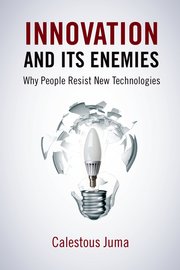Innovation and its EnemiesWhy People Resist New Technologies
|

|
 Diese Seite wurde seit 1 Jahr inhaltlich nicht mehr aktualisiert.
Unter Umständen ist sie nicht mehr aktuell.
Diese Seite wurde seit 1 Jahr inhaltlich nicht mehr aktualisiert.
Unter Umständen ist sie nicht mehr aktuell.
 Zusammenfassungen
Zusammenfassungen
 The rise of artificial intelligence has rekindled a long-standing debate regarding the impact of technology on employment. This is just one of many areas where exponential advances in technology signal both hope and fear, leading to public controversy. This book shows that many debates over new technologies are framed in the context of risks to moral values, human health, and environmental safety. But it argues that behind these legitimate concerns often lie deeper, but unacknowledged, socioeconomic considerations. Technological tensions are often heightened by perceptions that the benefits of new technologies will accrue only to small sections of society while the risks will be more widely distributed. Similarly, innovations that threaten to alter cultural identities tend to generate intense social concern. As such, societies that exhibit great economic and political inequities are likely to experience heightened technological controversies.
The rise of artificial intelligence has rekindled a long-standing debate regarding the impact of technology on employment. This is just one of many areas where exponential advances in technology signal both hope and fear, leading to public controversy. This book shows that many debates over new technologies are framed in the context of risks to moral values, human health, and environmental safety. But it argues that behind these legitimate concerns often lie deeper, but unacknowledged, socioeconomic considerations. Technological tensions are often heightened by perceptions that the benefits of new technologies will accrue only to small sections of society while the risks will be more widely distributed. Similarly, innovations that threaten to alter cultural identities tend to generate intense social concern. As such, societies that exhibit great economic and political inequities are likely to experience heightened technological controversies.
Drawing from nearly 600 years of technology history, Innovation and Ist Enemies identifies the tension between the need for innovation and the pressure to maintain continuity, social order, and stability as one of today's biggest policy challenges. It reveals the extent to which modern technological controversies grow out of distrust in public and private institutions. Using detailed case studies of coffee, the printing press, margarine, farm mechanization, electricity, mechanical refrigeration, recorded music, transgenic crops, and transgenic animals, it shows how new technologies emerge, take root, and create new institutional ecologies that favor their establishment in the marketplace. The book uses these lessons from history to contextualize contemporary debates surrounding technologies such as artificial intelligence, online learning, 3D printing, gene editing, robotics, and drones. It ultimately makes the case for shifting greater responsibility to public leaders to work with scientists, engineers, and entrepreneurs to manage technological change, make associated institutional adjustments, and expand public engagement on scientific and technological matters.
 Dieses Buch erwähnt ...
Dieses Buch erwähnt ...
 Personen KB IB clear | Erik M. Conway , Naomi Oreskes | ||||||||||||||||||
 Begriffe KB IB clear |  Innovation Innovation innovation
, innovation
,  Synthetische Biologie Synthetische Biologie
| ||||||||||||||||||
 Bücher |
|
 Zitationsgraph (Beta-Test mit vis.js)
Zitationsgraph (Beta-Test mit vis.js)
 Volltext dieses Dokuments
Volltext dieses Dokuments
 Bibliographisches
Bibliographisches 
 Beat und dieses Buch
Beat und dieses Buch
Beat hat dieses Buch während seiner Zeit am Institut für Medien und Schule (IMS) ins Biblionetz aufgenommen. Beat besitzt kein physisches, aber ein digitales Exemplar. (das er aber aus Urheberrechtsgründen nicht einfach weitergeben darf). Aufgrund der wenigen Einträge im Biblionetz scheint er es nicht wirklich gelesen zu haben. Es gibt bisher auch nur wenige Objekte im Biblionetz, die dieses Werk zitieren.














 Biblionetz-History
Biblionetz-History